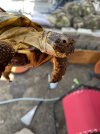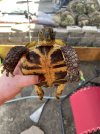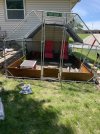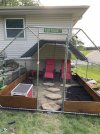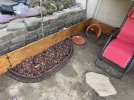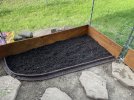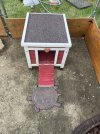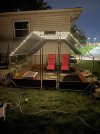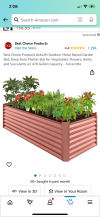Hi y’all, there’s some backstory here that I feel compelled to share, but if you just want to get to meat of it, skip to the second paragraph, lol.
So I’m not really sure where to start here, but I have a 12 year old female Russian tortoise named Pepper. My partner got Pepper for my step daughter a couple of years ago and has based all of the care for Pepper on the knowledge he gained working at Petco 15 years ago. I thought he knew what he was doing and so I didn’t intervene (which doesn’t mean that this isn’t still partially on me, since I personally chose not to do the research on an animal coming into my house and just took his word for it). He in fact did not know what he was doing. I did not realize that she was living in unacceptable conditions until a couple of weeks ago when I was doing research on aquatic turtle husbandry (my microbiology lab has 2 red eared sliders as pets and they’re not in great conditions so I was putting together a care sheet to present to the biology department in hopes of getting their enclosures upgraded). I said to myself “huh, if aquatic turtles need about 100 gallons of swimming water minimum to be happy, then there’s no way that Pepper has enough space in her 40 gallon terrarium”. Guttural shock and horror when I realized how seriously we were not meeting her care needs. Not to overshare, but my partner and I did not sleep in the same bed for several days, lol.
Ever since I have been manically researching best practices and have spent well over a grand constructing a 9’x12.5’ outdoor enclosure for Pepper. It’s still in progress, but I’m hoping to be done this week. With that being said, we’ve had an insane amount of rain and an insane number of thunderstorms/ tornadoes this last month and I don’t know what the rest of the summer will bring, so I’d like to have a nice indoor enclose for her as well (plus idk if she’ll be in good enough health to brumate this winter, I was planning on having her looked over by my exotics vet when we get a little closer to that time). I was thinking of using a 4’x8’x1’ raised garden bed and then lining the bottom with a 4’x8’ sealed plywood board. I could even caulk the 2 pieces together. I have cats so I would need a screen of some sort and was thinking of constructing a lid using wood and some kind of strong wired mesh. Pepper currently has a mercury vapor bulb, but I’m gathering that those are not great, so I was thinking of the Arcadia t5 bulb? Do I need more than one for such a large enclosure? And then I’ve also seen people say to have heat and UV separate, is that correct? I’m assuming I should have multiple basking spots in the enclosure with multiple hides? We’ve always used coconut coir for substrate as our other reptiles and my tarantulas use it, is that okay? And if so, how many inches of substrate will she need? Basking temp should be 95-100 and ambient temp should be around 80, yes? Any other advice would be very, very welcome.
Pic of Pepper soaking in the sun for tax (don’t worry, she can very much get out of that basin by herself if she gets too hot and she’s supervised the whole time!)

So I’m not really sure where to start here, but I have a 12 year old female Russian tortoise named Pepper. My partner got Pepper for my step daughter a couple of years ago and has based all of the care for Pepper on the knowledge he gained working at Petco 15 years ago. I thought he knew what he was doing and so I didn’t intervene (which doesn’t mean that this isn’t still partially on me, since I personally chose not to do the research on an animal coming into my house and just took his word for it). He in fact did not know what he was doing. I did not realize that she was living in unacceptable conditions until a couple of weeks ago when I was doing research on aquatic turtle husbandry (my microbiology lab has 2 red eared sliders as pets and they’re not in great conditions so I was putting together a care sheet to present to the biology department in hopes of getting their enclosures upgraded). I said to myself “huh, if aquatic turtles need about 100 gallons of swimming water minimum to be happy, then there’s no way that Pepper has enough space in her 40 gallon terrarium”. Guttural shock and horror when I realized how seriously we were not meeting her care needs. Not to overshare, but my partner and I did not sleep in the same bed for several days, lol.
Ever since I have been manically researching best practices and have spent well over a grand constructing a 9’x12.5’ outdoor enclosure for Pepper. It’s still in progress, but I’m hoping to be done this week. With that being said, we’ve had an insane amount of rain and an insane number of thunderstorms/ tornadoes this last month and I don’t know what the rest of the summer will bring, so I’d like to have a nice indoor enclose for her as well (plus idk if she’ll be in good enough health to brumate this winter, I was planning on having her looked over by my exotics vet when we get a little closer to that time). I was thinking of using a 4’x8’x1’ raised garden bed and then lining the bottom with a 4’x8’ sealed plywood board. I could even caulk the 2 pieces together. I have cats so I would need a screen of some sort and was thinking of constructing a lid using wood and some kind of strong wired mesh. Pepper currently has a mercury vapor bulb, but I’m gathering that those are not great, so I was thinking of the Arcadia t5 bulb? Do I need more than one for such a large enclosure? And then I’ve also seen people say to have heat and UV separate, is that correct? I’m assuming I should have multiple basking spots in the enclosure with multiple hides? We’ve always used coconut coir for substrate as our other reptiles and my tarantulas use it, is that okay? And if so, how many inches of substrate will she need? Basking temp should be 95-100 and ambient temp should be around 80, yes? Any other advice would be very, very welcome.
Pic of Pepper soaking in the sun for tax (don’t worry, she can very much get out of that basin by herself if she gets too hot and she’s supervised the whole time!)

